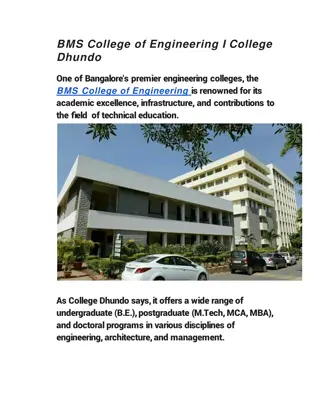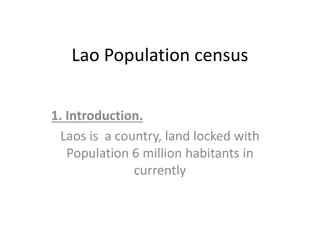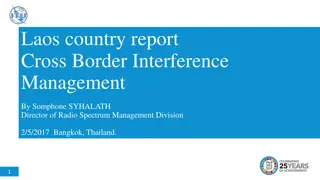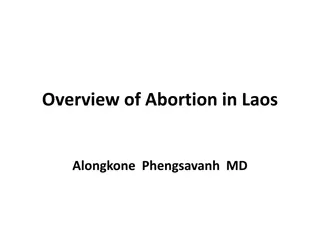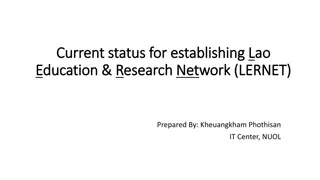Factors Influencing BMS Use and its Impact on Health and Nutrition Behavior in Laos
Study conducted by Phetsavanh Chanthavilay, MD, PhD, focuses on factors influencing mothers and families to use BMS products in Laos and how this impacts health, nutrition behavior, and economics. The research aims to provide insights into the low exclusive breastfeeding rates and the challenges faced in effective implementation, particularly in ethnic settings and individuals with high socio-economic status. The study design includes qualitative surveys such as FGDs and IDIs in various villages within Luang Namtha Province, targeting mothers, fathers, and key informants. Initial results show varied breastfeeding practices across different ethnic groups and settings, shedding light on the reasons for BMS use and not practicing exclusive breastfeeding.
Uploaded on Aug 14, 2024 | 0 Views
Download Presentation

Please find below an Image/Link to download the presentation.
The content on the website is provided AS IS for your information and personal use only. It may not be sold, licensed, or shared on other websites without obtaining consent from the author. Download presentation by click this link. If you encounter any issues during the download, it is possible that the publisher has removed the file from their server.
E N D
Presentation Transcript
Study on factors influencing mothers and family members to use BMS products and how it affects health, nutrition behaviour, and economics Phetsavanh Chanthavilay, MD, PhD Research consultant
Background and rational Globally, the coverage of EBF during the first six months of age is low, only about 40% In Lao PDR, EBF is about 44.9%: lower in rural setting, might due to high rate of BMS use Ensuring effective implementation remains a challenge particularly in ethnic settings and people with high socio-economic status The factors influencing the BMS use is unknown in Lao context.
Objective of the survey To provide in-depth analysis of factors influencing mothers and caregivers of child under 3 years old to use BMS products and how it affects health, nutrition behavior, and economics in Luang Namtha Province.
Methodology Study design o Qualitative survey: FGD and IDI in 6 villages in Namtha, Sing and Long districts in Luang Namtha province, representing the ethnicity and setting Study population: o Mother and father with children under 3 years old o FGD: father and mother groups o IDI: mothers o Key informants: VHV, healthcare worker from health center, district health office Key informants from Vientiane capital and the provincial level
Summary of exclusive breastfeeding practice (Data from FGDs) Categories Mean duration of breastfeeding (Months) 12.7 Proportion of EBF (%) Breastfeeding until 2 years (%) Reason of BMS use Reason of not EBF Colostrum (%) Overall Setting: Long district Sing district Namtha district Ethnicity: Akha ethnics: Rural setting Semi-urban/urban Leu ethnics: Rural setting Semi-urban/urban Hmong ethnics (Rural setting) Kamou ethnics (Semi-urban/urban) 40 Work 0 90 Healthy 30 80 10 Work Work Work 0 0 0 13.0 12.3 13.0 100 100 80 Healthy Healthy Healthy 30 0 70 80 100 50 Work work work Work - work 0 0 0 0 0 0 13.0 12.0 14.0 12.3 10.5 14.0 100 100 100 100 100 100 Work work work Healthy Healthy Healthy 20 Work 0 13.0 80 Healthy 0 work 0 Unknown 80 Healthy
Knowledge and attitude toward breastfeeding Knowledge: The level of knowledge towards breastfeeding is relatively low. The majority of simply stated that breastmilk helps their children to be healthy. Some others even thought that there was no difference in benefit between breastmilk and BMS. They did not know how long breastfeeding should be continued to maximize the benefit Attitude: They perceived that breastmilk is always good despite lack of knowledge about its benefits. The positive attitude towards breastfeeding was clearly revealed in mothers who tried their best to feed their child with breastmilk by bringing their child with them to the farm and returning home for giving breastmilk.
Barriers and constraints of EBF 6 months of life (1) Sociocultural, economic context 1. Work/employment Work is the most common constraint affecting EBF practice regardless of ethnicity, belief and residency. Farming requires them to work for a specific time and meet a specified amount of production. 2. Income and education level Mothers with lower education and economic status tend to have less power to decide on how to feed the child or to have good knowledge and practice toward breastfeeding. 3. Traditional belief Some beliefs remain dominant in rural setting regardless of ethnicity. Feeding with meal before 6 months of age because breastfeeding is not sufficient for their children. Feeding them with meal will help them to grow and become healthy.
Barriers and constraints of EBF 6 months of life (2) Physical factors 1. Insufficient breastmilk: Very common in first time mothers and cesarean case regardless of setting and ethnicity. Postpartum food taboo might also be responsible for insufficient breastmilk cases and postpartum depression 2. Mother s illness: Breastmilk is danger, suggested to stop by healthcare. Other factors 1. Misleading advertising of BMS: in particular from Thai TV, which includes: Helping children grow up faster and become smart and healthy. 2. Lack of knowledge towards solution for breastfeeding Almost all participants did not know that they could pump breastmilk and store it in the fridge for their children.
Factors influencing increase of BMS use in LNT province (1) Lack of knowledge and misconception towards BMS use The interviews revealed that most of our participants had quite low degrees of understanding on BMS. Many people thought that it provides similar benefit as breastmilk. Several people even considered that BMS is better than breastfeeding, because breast milk can cause diarrhea to their children, so they decided to shift to BMS. Many lack knowledge on the impact and side-effect of BMS use and did not report any experiences of ill impact from BMS, regardless of ethnicity and location. Belief and attitude that favors BMS The majority of participants had a good attitude towards BMS. They believe that BMS is an important sources of nutrient and vitamins and will help their child grow up and be intelligent. Some of our participant perceived that giving BMS to children make them fuller for longer, and you don t need to feed your children more often.
Factors influencing increase of BMS use in LNT province (2) Returning to work and Insufficient breastmilk : similar to EBF Social factors 1. Advertisement Advertisement from Thai TV is the main source of BMS advertisement regardless of the type of BMS including growing-up milk. 1. Healthcare workers The advice from healthcare workers to use BMS exist in the study sites. This occurs in the case of insufficient breastmilk at birth. 2. Peers influence The word-to-mouth is the common source of information and ancient approach of learning in the community. Many mothers reported that they have seen their peers feed their children with BMS, and found that their children looked healthy. 3. Family s influence The decision of BMS use is usually made by related family members, which include parents or parents-in law and husband. People keep practicing what they found is good according to their previous experiences.
Factors influencing increase of BMS use in LNT province (3) Other factors 1. Child adoption 2. Economic status Economic status is another determinant affecting BMS use particularly in semi-urban/urban setting. 3. Body shape Body shape concern is rarely a reason of BMS use, but currently found in some case in urban setting.
Impact of BMS use 1. Impact of BMS use to children health Mothers perceive that BMS use was not a cause of child s illness. Instead, the attribute the illness to specific BMS type being unsuitable for the child or contamination of equipment. Therefore, when a child falls ill, mothers change the type of BMS and clean the equipment better, instead of stopping the use of BMS. 2. Impact of the BMS use to the economic in the families No respondents reported side-effect of BMS use. This might be the reason why mother and family still decide to use BMS despite its price. We found that the impact of BMS use was found only among condensed milk use. This included diarrhea and malnutrition. The use of BMS and options was decided based on the respondents experiences of the side-effect.
Conclusion People replace breastfeeding with BMS when 1. They have to go to work, and leave their child with parents or parents-in law at home, 2. When they do not have sufficient breastmilk for first-time mothers or in long-term breastmilk feeding, and 3. When they receive the information from family and their peers. Other factors are less common in BMS use, but necessary to take into account: 1. Lack of knowledge and misconception on BMS use, belief and attitude favoring BMS, social factors (advertisement, healthcare workers, peers and family influence), child adoption, economic status and body shape. 2. The lack of negative BMS impact or side-effect experienced among BMS users might contribute to the increase of BMS.
Recommendation Urgent need of guidance and service improvement for insufficient breastmilk particularly for first-time mothers. A more effective communication for breastfeeding and BMS use education campaigns: brochure and videos in local languages, using local people to educate villagers rather than healthcare workers: Benefit of breastfeeding Side-effect of BMS use Alternative method of breastfeeding practice while working








